John Pizzarelli: Swinging the Great American Songbook and Beyond

Top 10 jazz guitarists of all times begins with John Pizzarelli. Born in 1960 with a guitar in his genes, John Pizzarelli is a jazz maestro who breathes new life into the classics. Son of legendary swing guitarist Bucky Pizzarelli, music was his lullaby, his playground, and his destiny. By age 6, he was strumming, later adding trumpet to his repertoire. Teenage years found him jamming with Benny Goodman and Les Paul, soaking up the secrets of swing and improvisation.
Formal education took a backseat to the apprenticeship he cherished most: learning from his father. This mentorship laid the foundation for Pizzarelli’s signature style – a blend of virtuosic guitar playing, smooth vocals, and a playful, infectious swing. He emerged in the 80s, captivating audiences with his reinterpretations of the Great American Songbook, injecting them with wit and warmth.
But Pizzarelli’s musical canvas extends far beyond the standards. He’s a master interpreter of Paul McCartney, Neil Young, and even Joni Mitchell, infusing their songs with the same swinging spirit that animates Cole Porter and Gershwin. He’s collaborated with giants like James Taylor and Rosemary Clooney, earning a Grammy for his work on Taylor’s “American Standard.”
Beyond the studio, Pizzarelli is a master showman. His live performances are bursts of energy and humor, sprinkled with insightful anecdotes and playful asides. He co-hosts “Radio Deluxe” with his wife, singer Jessica Molaskey, spreading the joy of jazz through the airwaves.
John Pizzarelli is more than a musician; he’s a storyteller, a charmer, and a champion of the American song. With every note, he reminds us that jazz isn’t a museum exhibit, but a vibrant, living language, forever evolving and captivating hearts.
Emily Remler: A Shooting Star of Bebop
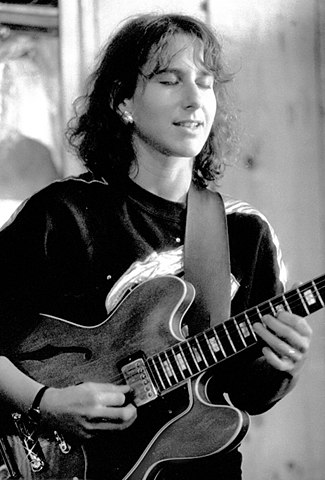
Emily Remler, born in 1957, was a force of nature on the jazz guitar, blazing across the scene in the 1980s before her life tragically ended at just 32. Though brief, her career left an indelible mark, reminding us of the power of passion and dedication in shaping musical brilliance.
Her journey began at 10, strumming on a hand-me-down guitar. Initially drawn to rock and roll, she found her true calling at Berklee College of Music, immersing herself in the giants of jazz – Wes Montgomery, Miles Davis, John Coltrane. Her immersion was fervent, her playing characterized by a fiery swing and a meticulous grasp of bebop language.
New Orleans served as her launching pad, where she honed her chops in blues and jazz clubs. In 1981, her debut album, “Firefly,” ignited the scene. Critics marveled at her technical prowess and deep understanding of tradition, yet sensed a unique voice emerging. That voice blossomed with subsequent releases like “Take Two” and “Catwalk,” showcasing her ability to swing effortlessly between fiery bebop lines and smooth ballads.
She wasn’t content with mere reverence. Remler explored, collaborating with Astrud Gilberto on Brazilian grooves and even recording two instructional videos, eager to share her knowledge. In 1985, Down Beat magazine crowned her “Guitarist of the Year,” a testament to her meteoric rise.
Remler’s legacy isn’t solely defined by accolades. Her playing exuded joy, a contagious swing that drew listeners into her world. It was a joy tinged with melancholy, reflecting the fleeting nature of her own journey. With each note, she poured her heart out, leaving behind a treasure trove of recordings that continue to inspire guitarists and jazz lovers alike.
Emily Remler, the shooting star of bebop, may have shone brightly for a short time, but her light still illuminates the path for those who dare to embrace the fire of improvisation and the magic of jazz.
The Incredible Jazz Guitar of Wes Montgomery
Wes Montgomery: The Thumb That Redefined Jazz Guitar

John Leslie “Wes” Montgomery (1923-1968) was an American jazz guitarist who revolutionized the instrument with his unique thumb-picking technique and soulful melodies. Born in Indianapolis, Indiana, Montgomery’s musical journey began late, at the age of 19, after hearing the electrifying riffs of Charlie Christian. He taught himself to play, eschewing the traditional pick in favor of his thumb, creating a warm, rich sound that resonated with audiences.
Montgomery’s career blossomed in the 1950s and 60s. He honed his craft alongside his brothers, Monk and Buddy, on the club scene and in early recordings for Pacific Jazz. His 1959 album, “The Incredible Jazz Guitar of Wes Montgomery,” became a landmark, showcasing his innovative technique and melodic inventiveness. Tracks like “Round Midnight” and “West Coast Blues” still stand as cornerstones of guitar jazz.
Montgomery’s playing wasn’t just about technical brilliance; it was imbued with emotion and swing. He could weave intricate chord voicings into bluesy melodies, effortlessly transitioning from ballad tenderness to uptempo groove. His influence extended beyond jazz, inspiring guitarists in rock, soul, and funk.
Montgomery’s later career saw him experiment with orchestral arrangements and explore pop-infused sounds, further solidifying his versatility and appeal. He received a Grammy Award in 1965 for his contributions to “A Day in the Life of a Bluesman,” showcasing his ability to bridge generations and musical styles.
Sadly, Montgomery’s life was cut short at the age of 45 due to a heart attack. Yet, his legacy as a pioneer of jazz guitar remains undimmed. His sound continues to inspire and captivate music lovers, his thumb a testament to the boundless creativity and expressive power of jazz.
Here are some of Wes Montgomery’s most notable achievements:
-
Pioneered the use of the thumb for fingerstyle guitar playing, creating a signature warm and percussive sound.
-
Recorded over 30 albums, spanning hard bop, soul jazz, post-bop, and pop-oriented styles.
-
Received a Grammy Award for Best Jazz Instrumental Album in 1965.
-
Influenced countless guitarists in jazz, rock, soul, and funk, including Pat Metheny, George Benson, and John Scofield.
Wes Montgomery’s contributions to jazz go far beyond technical wizardry. He was a storyteller, a soulful improviser, and a true innovator who redefined the very sound of the guitar. His music continues to resonate with audiences today, a testament to his timeless talent and enduring legacy.
Joe Pass: A Virtuosic Whisper on Six Strings
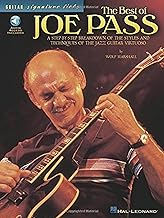
Born Joseph Anthony Passalacqua in 1929, Joe Pass wasn’t just a jazz guitarist; he was a whisperer on six strings, weaving intricate melodies and soulful harmonies that captivated audiences worldwide. From his humble beginnings in New Jersey to his rise as a Grammy-winning superstar, Pass’s life was a testament to the transformative power of music.
His journey began not with a jazz legend, but with a cowboy movie. A nine-year-old Joe, mesmerized by Gene Autry’s on-screen twang, received his first guitar and promptly fell in love. He practiced relentlessly, honing his skills in smoke-filled backrooms and jam sessions, soaking up the sounds of swing and bebop like a sponge.
By his teenage years, Pass was already a seasoned professional, touring with big bands and gracing the stages of New York City. But success came hand-in-hand with hardship. Battling drug addiction for over a decade, Pass’s career stalled, his talent shrouded in darkness.
In 1962, however, Pass emerged from the shadows, clean and determined. His comeback album, “Sounds of Synanon,” showcased his raw talent and melodic genius. He quickly found himself collaborating with jazz giants like Oscar Peterson and Ella Fitzgerald, his fluid lines and improvisational brilliance leaving audiences breathless.
Pass wasn’t content with mere virtuosity. He possessed a deep understanding of melody and harmony, breathing new life into jazz standards and exploring the intricacies of bossa nova and pop. His solo concerts were masterclasses in musical storytelling, each note infused with emotion and nuance.
Throughout his career, Pass racked up accolades, including a Grammy Award for Best Jazz Instrumental Album in 1986. He taught countless aspiring musicians, sharing his knowledge and passion with a generosity that mirrored his own artistic spirit.
Sadly, Pass’s life was cut short in 1994. But his legacy as a guitar icon and jazz innovator lives on. His recordings continue to inspire generations of musicians, his whisper on six strings a timeless reminder of the magic that unfolds when passion meets mastery.
Here are some key points about Joe Pass’s life and achievements:
-
Born in 1929 in New Jersey, started playing guitar at the age of 9.
-
Overcame a decade-long struggle with drug addiction to become a major jazz star.
-
Collaborated with renowned musicians like Oscar Peterson, Ella Fitzgerald, and Dizzy Gillespie.
-
Won a Grammy Award for Best Jazz Instrumental Album in 1986.
-
Known for his virtuosic technique, melodic inventiveness, and soulful interpretations of jazz standards.
-
Considered one of the greatest jazz guitarists of all time.
Joe Pass’s story is one of resilience, creativity, and sheer love for music. His guitar whispers forever, reminding us that even the darkest nights can give way to melodies that touch the soul.
The Great Artistry of Django Reinhardt
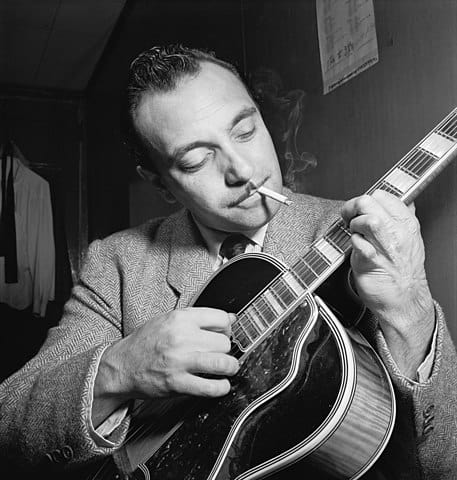
Django Reinhardt: Gypsy Jazz Pioneer
Born Jean “Django” Reinhardt in 1910 in a Gypsy caravan in Belgium, Reinhardt’s life was a story of overcoming adversity and musical genius. At 18, a fire tragically injured his left hand, leaving two fingers permanently paralyzed. Undeterred, Django developed a unique playing style using only three fingers, revolutionizing the guitar and creating a genre known as Gypsy jazz.
Reinhardt’s musical journey began on the streets of Paris, absorbing the sounds of jazz, swing, and traditional Romani music. In the 1930s, he formed the Quintette du Hot Club de France with violinist Stéphane Grappelli. Their vibrant, melodic music captivated audiences throughout Europe, even during the dark days of Nazi occupation.
Django’s music was a fusion of styles. His improvisations were fiery and complex, yet grounded in catchy melodies and infectious rhythms. He wove elements of swing, blues, and Romani music into his own unique tapestry, creating a sound that was both sophisticated and accessible.
Beyond his technical mastery, Django was a storyteller through music. His solos painted vivid pictures, evoking emotions from deep melancholy to unbridled joy. He had a natural gift for melody, crafting instantly recognizable tunes like “Nuages” and “Minor Swing” that remain jazz standards today.
Reinhardt’s influence extended far beyond jazz. He inspired countless guitarists across genres, from rock legend Jimi Hendrix to country icon Chet Atkins. His legacy lives on in Gypsy jazz bands around the world, and his music continues to fill hearts with joy and wonder.
Here are some key points about Django Reinhardt’s life and achievements:
-
Born in 1910 in Belgium, of Romani descent.
-
Developed a unique guitar style after losing two fingers in a fire.
-
Led the Quintette du Hot Club de France, one of the most popular jazz groups of the 1930s.
-
Pioneered Gypsy jazz, a fusion of swing, blues, and Romani music.
-
Influenced countless guitarists across genres.
-
Considered one of the greatest jazz guitarists of all time.
Django Reinhardt’s story is a testament to the power of human spirit and the boundless creativity of music. His music continues to resonate with audiences today, a reminder that even in the face of adversity, the human spirit can soar on the wings of melody.
Lee Ritenour: Beyond Six Strings, A Weave of Genres
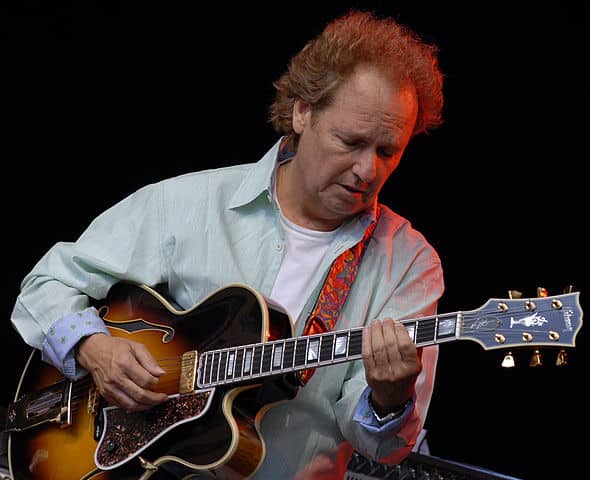
Lee Ritenour isn’t just a guitarist; he’s a sonic tapestry, seamlessly weaving jazz, pop, and fusion into a vibrant musical canvas. Born in 1952 in Los Angeles, music coursed through his veins from a young age. By 12, he was jamming with legends like Chuck Berry, his fingers dancing across the fretboard with an innate understanding of melody and groove.
Ritenour’s career blossomed in the 70s. He joined the Six Flags band, backing up pop icons like Steely Dan, and soon found himself in high demand as a session musician. His versatility shone through; his solos adorned albums by Quincy Jones, Carly Simon, and even Pink Floyd. But Ritenour craved his own voice.
His solo albums exploded onto the scene, showcasing his virtuosity while pushing genre boundaries. From the smooth jazz grooves of “Captain Fingers” to the infectious fusion of “Electric Blue,” Ritenour crafted music that moved feet and souls alike. He collaborated with giants like Chick Corea and John Patitucci, forming the Elektric Band, a melting pot of musical styles that captivated audiences worldwide.
Ritenour’s passion extends beyond performance. He’s a Grammy Award-winning composer, scoring films and documentaries with the same depth and emotion he pours into his music. He’s also a dedicated educator, sharing his knowledge through clinics, masterclasses, and his own educational materials.
Today, Ritenour stands as a guitar legend, not just for his technical prowess, but for his ability to bridge genres and connect with audiences on a deeper level. His music is a vibrant conversation, a dialogue between jazz improvisation and pop accessibility, all woven together with the soulful touch of a master storyteller.
Here are some key points about Lee Ritenour’s life and achievements:
-
Born in 1952 in Los Angeles, began playing guitar at a young age.
-
Renowned session musician, contributing to countless albums across genres.
-
Prolific solo artist, blending jazz, pop, and fusion in his music.
-
Grammy Award-winning composer, scoring films and documentaries.
-
Dedicated educator, sharing his knowledge through clinics and masterclasses.
Lee Ritenour’s career is a testament to the power of musical exploration and the endless possibilities of the six-string. His music continues to evolve, pushing boundaries and leaving listeners with a sense of wonder and joy, reminding us that the true magic of music lies in its ability to weave magic across genres and touch hearts across generations.
Mr. 335: Larry Carlton, a Smooth Jazz Icon (with Images)
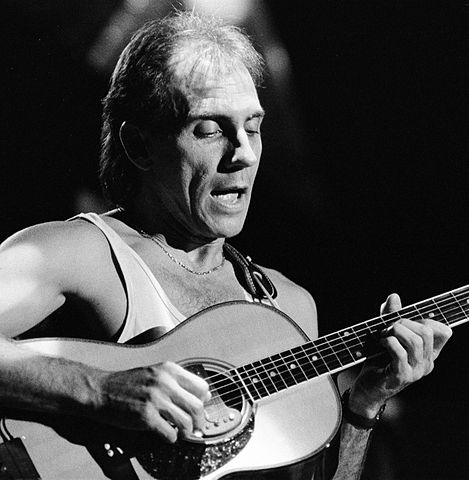
Larry Carlton, nicknamed “Mr. 335” for his iconic Gibson ES-335 guitar, is not just a guitarist; he’s a sonic sculptor, shaping smooth jazz landscapes with his lyrical melodies and velvety phrasings. Born in Torrance, California, in 1948, music was his cradle song. By six, he was plucking away on his first guitar, mesmerized by the jazz greats gracing his radio. Joe Pass, Wes Montgomery, and Barney Kessel became his teachers, their styles weaving into the tapestry of his musical soul.
Carlton’s journey began in Los Angeles’ vibrant club scene. Honing his chops alongside his brother, Herb, he soon found himself in the studio, lending his melodic magic to the burgeoning pop and rock scene of the 60s. Steely Dan, Joni Mitchell, and Carly Simon are just a few of the legendary names whose recordings bear the stamp of his exquisite guitar work.
But Carlton’s true voice emerged in the 70s with his solo albums. Records like “With a Little Help from My Friends” and “Mr. 335 Live” showcased his unique blend of smooth jazz, blues, and pop, each note radiating warmth and effortless swagger. His solos, like miniature sonic journeys, traversed a landscape of intricate melodies and soulful improvisation, leaving listeners breathless and wanting more.
The 80s saw Carlton’s star ascend even further. His signature licks graced the theme song of the hit TV series “Hill Street Blues,” earning him his first Grammy Award. Collaborations with giants like Stevie Wonder and Quincy Jones solidified his reputation as a world-class musician, bridging genres and captivating audiences across the globe.
Beyond his solo work, Carlton has been a cornerstone of the smooth jazz supergroup Fourplay since 1997. His interplay with fellow virtuosos like Chick Corea and John Patitucci creates a musical alchemy that inspires and uplifts.
Through it all, Carlton remains a humble master, sharing his knowledge with aspiring musicians through clinics and masterclasses. His passion for music is infectious, reminding us that the magic lies not just in technical mastery, but in the heart and soul poured into every note.
Larry Carlton’s legacy isn’t just etched in platinum records and awards; it’s woven into the very fabric of smooth jazz. He’s a pioneer, a teacher, and above all, a storyteller, his guitar spinning tales of joy, heartache, and everything in between. His music is a warm embrace, a sonic sanctuary where melody reigns supreme, and every note whispers, “This is smooth jazz, and Mr. 335 is its king.”
Here are some key points about Larry Carlton’s life and achievements:
-
Born in 1948 in Torrance, California.
-
Renowned session guitarist, contributing to countless albums across genres.
-
Pioneered and popularized smooth jazz with his solo albums.
-
Grammy Award winner for Best Pop Instrumental Performance (1981).
-
Member of the smooth jazz supergroup Fourplay since 1997.
-
Dedicated educator and mentor to aspiring musicians.
Carlton’s music is a timeless testament to the power of melody, improvisation, and sheer love for the guitar. It’s a journey for the soul, an invitation to lose yourself in the smooth grooves and bask in the warm glow of a true musical master. So, turn up the volume, grab your headphones, and let Mr. 335 paint his sonic landscapes on your canvas of imagination.
Charlie Byrd (1925-1999)
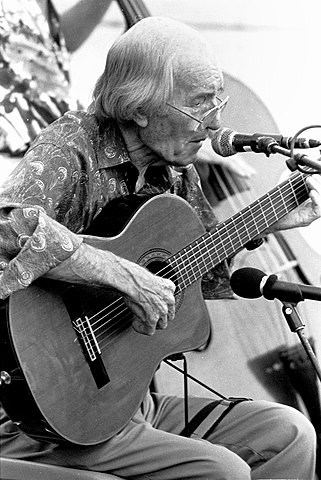
Charlie Byrd: Bringing Bossa Nova to the World
Charlie Byrd, best known for his collaboration with Stan Getz on the landmark album “Jazz Samba,” was an American jazz guitarist who played a pivotal role in introducing bossa nova to the North American audience. Born in Suffolk, Virginia, in 1925, Byrd’s love for music blossomed early, thanks to his mandolinist and guitarist father. By 10, he was already strumming the acoustic steel guitar, laying the foundation for his future musical journey.
Byrd’s early musical ventures saw him playing swing and bebop with local groups, but it was his fascination with classical guitar that truly shaped his sound. He spent time studying with renowned maestros like Sophocles Papas in Siena and Andrés Segovia in Spain, honing his technical skills and infusing his playing with a delicate, lyrical touch.
Returning to the United States in the late 1950s, Byrd found himself captivated by the emerging Brazilian sound of bossa nova. Its smooth melodies and intricate rhythms resonated with his sensibilities, and he set out to explore the genre through his own lens.
The turning point came in 1961 when Byrd and saxophonist Stan Getz met and, struck by a shared passion for bossa nova, decided to collaborate. Their 1962 album, “Jazz Samba,” became an instant sensation. Byrd’s graceful guitar lines and Getz’s soaring saxophone melodies breathed new life into Brazilian classics like “Desafinado” and “The Girl from Ipanema,” igniting a worldwide bossa nova craze.
“Jazz Samba” wasn’t just a commercial success; it was a cultural bridge. It introduced North American audiences to the beauty of bossa nova and paved the way for countless bossa nova-inspired recordings and performances. Byrd, with his gentle virtuosity and deep understanding of the genre, played a crucial role in this musical exchange, forever etching his name in the history of bossa nova.
Beyond bossa nova, Byrd was a versatile musician, equally adept at interpreting standards, exploring folk and classical themes, and collaborating with diverse artists. He continued to record and perform well into the 1990s, leaving behind a rich legacy of music that continues to inspire and enchant.
Key points about Charlie Byrd:
-
Played a pivotal role in introducing bossa nova to North America.
-
Known for his collaboration with Stan Getz on the landmark album “Jazz Samba.”
-
Combined elements of jazz, bossa nova, and classical guitar in his unique style.
-
Prolific artist with a vast discography encompassing various genres.
-
Considered a bridge between American jazz and Brazilian music.
Charlie Byrd’s story is one of passion, artistry, and cultural exchange. His gentle approach to the guitar and his deep understanding of music resonated with audiences worldwide, earning him a place among the legends of jazz and bossa nova. Even today, his music continues to transport listeners to sun-drenched Brazilian beaches and smoky jazz clubs, reminding us of the power of music to connect hearts across cultures and generations.
Kenny Burrell: A Quiet Giant of Jazz Guitar
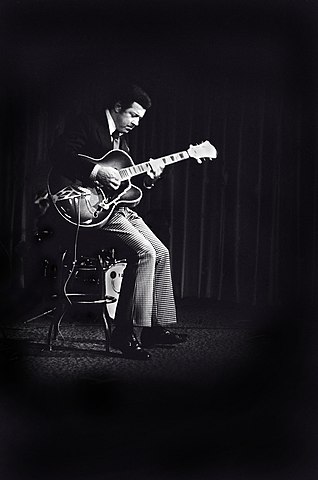
Kenny Burrell, born in Detroit in 1931, is a titan of jazz guitar, yet his gentle demeanor and introspective playing style belie his immense talent and influence. Unlike the flamboyant showmanship of some, Burrell’s magic lies in subtlety, weaving intricate melodies and soulful harmonies with a quiet confidence that captivates the listener.
His journey began at age 14, captivated by the sounds of Charlie Christian and Django Reinhardt. He honed his skills in Detroit’s vibrant jazz scene, jamming alongside masters like Tadd Dameron and Lucky Thompson. By the 1950s, he was making waves in New York City, collaborating with jazz giants like Dizzy Gillespie, John Coltrane, and Cannonball Adderley.
Burrell’s recordings with these icons laid the foundation for his own solo career. Albums like “Blue Bash” and “Introducing Kenny Burrell” showcased his unique voice – a blend of bluesy grit, sophisticated bebop harmony, and a deep understanding of melody. His solos were never mere displays of technical prowess; they were stories told through strings, each note infused with emotion and nuance.
Beyond his own music, Burrell became a sought-after educator and mentor. He taught at institutions like The New School and Berklee College of Music, sharing his knowledge and shaping the next generation of jazz greats. His influence can be heard in the styles of countless guitarists, from Pat Metheny to John Scofield.
Burrell’s career didn’t slow down with age. In the 1970s and 80s, he collaborated with vocalists like Tony Bennett and Nancy Wilson, showcasing his versatility and adaptability. He continued to release acclaimed solo albums, like “Midnight Blue” and “Groovin’…” each one a testament to his enduring musicality.
In 2016, Burrell received the NEA Jazz Masters Award, a fitting recognition of his lifetime contribution to the genre. Today, at 92, he remains an active figure on the scene, his gentle spirit and timeless music a source of inspiration and joy for audiences and musicians alike.
Here are some key points about Kenny Burrell:
-
Renowned jazz guitarist known for his introspective playing and soulful melodies.
-
Collaborated with some of the greatest names in jazz, including Dizzy Gillespie, John Coltrane, and Cannonball Adderley.
-
Prolific solo artist with a vast discography spanning over six decades.
-
Influential jazz educator and mentor.
-
Recipient of the NEA Jazz Masters Award (2016).
Kenny Burrell’s story is a testament to the power of quiet mastery and dedication. His music reminds us that sometimes, the most profound artistry lies in the delicate nuances, the whispered stories hidden within a single note. As long as jazz guitars sing, Kenny Burrell’s gentle genius will continue to resonate, etching his name among the true giants of the genre.
George Benson: Smooth Sailing Between Jazz and Pop
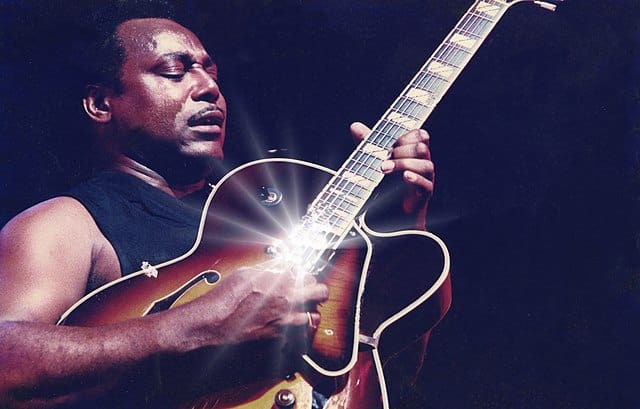
George Benson, born in Pittsburgh in 1940, is a musical chameleon, gracefully navigating the worlds of jazz, pop, and soul. Armed with a buttery-smooth voice and fingers that dance across his guitar, Benson has earned critical acclaim and widespread love from audiences across genres.
His journey began at age six, learning ukulele before embracing the guitar. By his teens, he was already a seasoned performer, dazzling audiences with his fiery blend of bebop and blues. The legendary Hammond B3 organist Jimmy Smith took Benson under his wing, opening doors to the jazz world.
The 1960s and 70s saw Benson rise to jazz stardom. Albums like “Breezin'” and “Innerlude” showcased his virtuosity and melodic inventiveness, earning him Grammy Awards and establishing him as a jazz guitar icon. But Benson, a restless soul, yearned for new horizons.
The 1980s witnessed his daring foray into pop. Collaborations with Quincy Jones and Willie Nelson led to global hits like “Give Me the Night” and “Greatest Love,” propelling him to pop superstardom. While some purists balked, Benson’s soulful singing and smooth grooves resonated with millions, proving his musical genius wasn’t confined by genre labels.
Throughout his career, Benson has remained a prolific artist, exploring funk, R&B, and even Brazilian music. He’s collaborated with diverse artists like Stevie Wonder, Aretha Franklin, and Al Jarreau, his chameleon-like adaptability constantly surprising and delighting audiences.
But Benson never fully left his jazz roots behind. He returns to them regularly, releasing critically acclaimed jazz albums like “Guitar Man” and “Grateful.” His live performances are electrifying displays of both his soulful vocals and his electrifying guitar work, a testament to his versatility and enduring love for the genre that nurtured him.
Today, at 83, George Benson remains a musical force. His warm smile, smooth voice, and masterful guitar playing continue to captivate audiences and inspire musicians across generations. He is a reminder that artistry knows no boundaries, that true talent can thrive and evolve amidst the currents of different genres, offering listeners a smooth sailing journey through the vast ocean of music.
Here are some key points about George Benson:
-
Renowned jazz guitarist and vocalist with a career spanning over six decades.
-
Blends jazz, pop, soul, and R&B with effortless grace.
-
Grammy Award-winning artist with hits like “Give Me the Night” and “Breezin’.”
-
Prolific collaborator, working with diverse artists like Quincy Jones, Willie Nelson, and Stevie Wonder.
-
Revered by jazz purists and pop fans alike.
George Benson’s story is a testament to the boundless nature of musical expression. He is a bridge between genres, a master storyteller whose melodies carry listeners on a journey of joy, soul, and pure musical magic. As long as his guitar sings and his voice soars, George Benson will continue to be a beacon of creativity, reminding us that music knows no boundaries, only limitless possibilities.
In conclusion, these top 10 jazz guitarists have not only made their mark in history, but they have also revolutionized the way we hear and appreciate music. From the smooth and soulful licks of George Benson to the intricate and complex solos of Joe Pass, each guitarist has brought their own unique style to the world of jazz guitar.
As a group, they have set the bar high for future generations, inspiring musicians around the globe to pick up a guitar and explore the endless possibilities of jazz. It’s impossible to say who is “the best” among them, as each guitarist has left an indelible mark on the genre in their own way. However, what is clear is that their music will continue to be celebrated and studied for years to come.
So let us not forget the incredible talent and contributions of John Pizzarelli, Emily Remler, Wes Montgomery, Dejango Reinhardt, Lee Ritenour, Larry Carlton, Charlie Byrd, Kenny Burrell, and George Benson. May we keep their legacy alive by listening to their music with open ears and open hearts. Let’s continue to support and celebrate all jazz musicians who strive towards excellence in their craft. Who knows? The next generation could bring us even more outstanding jazz guitarists that will make this list grow even longer! Keep on grooving and keep on swinging!


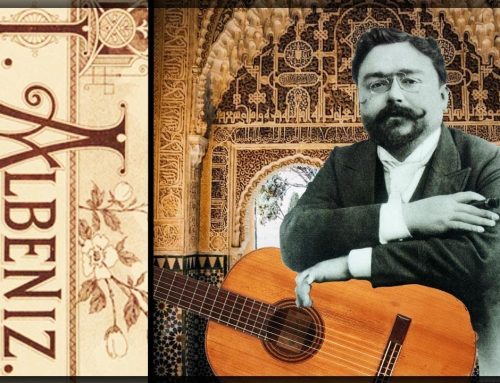


Leave A Comment